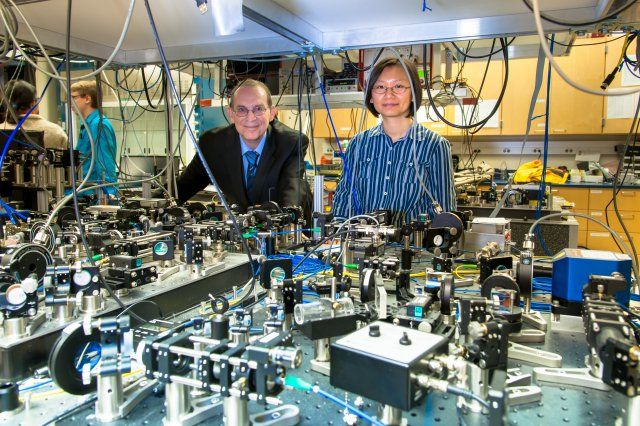Scientists at the U.S. Army Research Laboratory are pioneering data teleportation — for the real world.
When the USS Enterprise, from the hit television and movie series “Star Trek,” beamed individuals to and from the ship, the ship’s transporters were moving matter.
While fictional technology may stir the imagination, science fiction is more of an inspiration than reality. It often provides a spark of scientific inspiration that can lead to discoveries once considered unimaginable.
Today, Army scientists hope to send information from one location to another without the data being transmitted through the intervening space.
To reach this goal, Ronald E. Meyers leads a project that includes fellow physicist Patricia J. Lee and their teams that are collaborating with the Joint Quantum Institute at the University of Maryland at College Park. The groups have a 27-kilometer fiber optic connection between their laboratories.
“We use photons that go through the fiber in order to entangle the atoms at two different locations,” Meyers said.
A photon is an elementary particle and a basic building block of the universe. The team sends photons from one end of the fiber to the other. Once photons are entangled, they mysteriously respond to each other.
“The idea of entanglement is that when one photon is manipulated, the other photon will respond at a distance through a process that Einstein highlighted,” Meyers said. “What we’re going to do is to entangle the distant atoms using these photons. Once they’re entangled, then you do not need the fiber in between. You manipulate atoms here and atoms at another location will respond instantly with nothing in between.”
This effect is known as quantum teleportation using atoms and photons.
“You can communicate between these locations without information appearing to go through the intervening space,” Meyers said. “It’s mind-boggling.”
For the U.S. Army, a secure quantum communications network is a technology investment worth making. Meyers said physicists around the world are pursuing quantum teleportation research.
“One day we will have communication over worldwide distances with quantum repeaters as mediators at nodes in between,” Meyers said. “We’ll be able to teleport information globally. What we’ll have is tamper-resistant security.”
Cyber-security is a major concern for military and civilian sectors.
“This is important,” he said. “The greatest potential that a quantum communications network holds for the Army is secure communications.”
As quantum computing takes hold in the coming decades, the potential for hacking exponentially increases.
“Quantum computers will be able to easily decrypt communications that are currently secure,” Meyers said. “We’re talking decryption in seconds instead of years. That’s one reason why it’s vital for us to explore quantum encryption.”
Quantum research is building momentum, according to Lee.
“There are a lot of people worldwide who work on this type of research, and we are just a part of the community trying to make the next step a reality,” Lee said. “Our contribution is trying to set this up in a real-life. It’s very exciting.”
News reports of quantum research advances are growing.
The 2012 Nobel Prize in Physics went to physicist David Wineland for his quantum research at the National Institute of Standards and Technology.
“We would hope to have the quantum atomic memory fully going within the next year,” Meyers said. “There’s a lot of progress on it.”
The team is also striving to develop quantum repeaters.
“We can perform photon teleportation sooner, but having teleportation with quantum memory adding the atoms is really the key to massive changes in the U.S. communications system,” Meyers said. “We think that teleportation with atoms and photons is an important goal for the United States and we want to get it out of the laboratory and show that it’s possible over long distances.”
Consider a future battlefield with a Soldier, an unmanned aerial vehicle, a command and control element and access to a satellite.
“If you put entangled atoms at each of these locations and they’re moving around, then you can teleport data between the Soldier and the satellite … you can teleport to UAVs … you can teleport to command and control headquarters,” Meyers said. “We think it’s going to be the future for military communications. Now the strategic impact … it’s possible to get information out of your location without others getting it. This is a whole new technology will one day be common.”
Meyers and Lee agree that quantum data teleportation will become a dominant technology.
“There are several important applications for quantum information,” Lee said. “For our project here, one of our goals is to build a quantum sensor. Cold atoms can be used to sense acceleration and rotation and they can make very sensitive inertial navigation systems to guide the Soldier or vehicles. That’s a really important application if we can actually develop that technology.
“It’s also going to be very important for Soldiers on the battlefield to have secure communication and computational power that will offer capabilities exceeding anything that we have access to right now,” Lee said.
Like a perpetual jigsaw puzzle, Lee said their research continues to evolve.
“There will be many ways to use this tool. A lot of them we don’t even know about — they haven’t been thought of,” she said. “New things will come up and that’s how research, technology and science evolve.”
Meyers said the Army continues to fund quantum research in academia and other research institutions.
“The fundamental physics is there,” Meyers said. “We have to learn enough of the physics and some of the engineering to implement it and to demonstrate that it can be done. I think this is an evolutionary process that will cause a huge shift in communications.
“Remember, we put a man on the moon with very primitive computers and we developed an atomic bomb without a computer,” Meyers said. “The fact is we’re going to have these very powerful quantum computers with a lot of intelligence. They’ll be able to work over long distances without being intercepted. It’s going to change the world.”










